The general public’s understanding of issues surrounding bus lanes is being hampered by a lack of basic legwork by the local media and subsequently shoddy framing.
The sporadic release of bus lane penalty charge notice (PCN) statistics from the Department for Infrastructure (DfI) sparks cheap headlines and outrage spilling onto the radio airwaves. But a quick look at open data made openly available on the Open Data NI website (open all hours) shows we aren’t being told the whole picture – and the quality of public debate is suffering as a result.
“My worry here is that all of these headlines turn off a lot of shoppers, particularly in rural areas.”
Retail NI spokesperson, Nolan Show, BBC Radio Ulster, 8 August 2019
The most recent media incursion into bus lanes happened in August 2019, with a now typical dive into shock headlines:
The £1.5m bus lane camera… city centre road spy racks up huge fines tally in four years
Belfast Telegraph, 8 August 2019
Note the framing of the story with the word “spy” suggesting something underhand, even voyeuristic at work.
Even the venerable BBC chose neutral language (“using”) to describe a legal contravention:
Drivers fined £4.2m for using Belfast bus lanes
BBC News NI, 7 August 2019
One Belfast city centre bus lane camera raised £1.5m in fines in the past four years, official figures show. pic.twitter.com/ANVTH97047
— BBC News NI (@BBCNewsNI) August 7, 2019
The stories picked up on DfI’s published response to a simple information request looking for:
Information relating to Belfast City bus lanes, broken down by bus lane, including:
1) the total cost of introducing the bus lanes;
2) the cost of monitoring unauthorised use (cameras, etc.);
3) the amount generated via PCNs and other legal action; and
4) the total legal costs to the Department of any challenges.
DfI/2019-0052: EIR Request
The response detailed the total amount raised from PCNs issued from 22 June 2015 (when fixed and mobile bus lane cameras came online) to 28 February 2019.
This was a whopping £4.3 million across 38 locations, while the Donegall Square East bus lane fixed camera alone accounted for over a third of the total fines in Belfast at £1.5 million. Gold dust for journalists and editors.
According to the Newsletter “the figures were obtained from the Department of Infrastructure following a freedom of information request by the BBC.” If that’s the case, the responsibility fell first to the BBC to delve deeper into the topic.
There was no request to break the information down over time periods, but there didn’t need to be – DfI has made PCN information for each bus lane it operates available by month, since at least 2017, on its own website and the Open Data NI website. This is where important context and trend information remains out of reach to incurious journalists, and hence hidden (in raw form) from a public keen to debate the issue.
“Oh people can come up with statistics to prove anything Kent. Forfty percent of all people know that.”
Homer J Simpson
"Aw, people can come up with statistics to prove anything, Kent. Forfty percent of all people know that." pic.twitter.com/KEDB2ykLNi
— SimpsonsQOTD (@SimpsonsQOTD) March 24, 2014
So we did the work and here’s five things you really need to know about bus lane fines before the next round of outrage:
1. The number of drivers caught using bus lanes is significantly reducing, year on year
This gets right to the heart of trusting that responsible journalists will dig for the real story, not just act like red top hacks.
“I know the fines are annoying for people and it gets frustrating, but as people get used to the bus lanes those number of fines should go down.”
Councillor Malachi O’Hara, Nolan Show, BBC Radio Ulster, 8 August 2019
What does it say for the standard of journalism at the BBC, Belfast Telegraph and others that this has been the case for some time, yet no-one bothered to add it into the mix?
Mashing together all the fines from the start to finish will produce the same angry headlines from now until forever. For example, if zero bus lane fines were issued in the next 12 months, a headline next year stating “Shock as £4.3 million raked in from hard-pressed motorists over 5 years” would be valid and correct – but not enlightening in the slightest.
What does the trend data show us? A headline-deflating, narrative-crushing reduction in fines.
The lowest monthly total of fines since the start of the PCN regime had been February 2017 with 1,068 issued.
Five out of the last eight months have seen lower totals than that.
PCNs came into operation in the last week of June 2015 and during the first full six months (July to December) just under 30,000 PCNs were issued. Compare that with just over 6,400 fines during January to June 2019 means there has been a 78% reduction in the level of bus lane fines over four years.
The public needs to know about this. Journalists need to do better.
2. Annual fines are about to drop below original Departmental estimates
DfI is forever getting it in the ear from business lobbyists and quote-a-minute politicians looking to jump on that sweet, sweet motorist anger bandwagon. And, wholly unrelated to that latter characterisation, Jim Rodgers.
Headlines are churned out, fury is expressed, DfI gets hauled in to answer hard questions, the world turns. But what if the Department was about to make good on its initial estimates for bus lane fines?
“In total, 38 cameras across Belfast generated more than £4.2m between June 2015 and February of this year. Officials had originally estimated they would raise around £500,000 a year.”
Belfast Telegraph, 8 August 2019
(Did alarm bells go off in your head at the framing of that sentence?)
Following a dodgy start when fines went well beyond expectations (see that last graph again), the public has clearly become more aware of bus lanes and how it’s possible not to drive in them. So much so that the estimated total fines for 2019 (based on doubling the available January to June data) will be £580,000.
That’s down from £1.45 million in 2015 and a stone’s throw from the £500,000 level predicted by DfI at the outset. And if the overall trend continues, it’ll be well below that level by next year.
It’s amazing how you can spin a scandal out of almost nothing.
Will the same mini demagogues front up with praise for a government department actually meeting and bettering its targets?
3. Only around 2% of Donegall Square East drivers can’t operate a vehicle safely
Donegall Square East hosts “the £1.5m bus lane camera“, the media darling. It’s taken the brunt of criticism from the outset, as recognised by the NI Roads site:
“There has been some publicity recently around the number of tickets that have been issued via the new fixed and mobile cameras that monitor the bus lanes in the city centre. The Donegall Square East camera has been busiest.
If the signage and bus lanes are clearly marked, and the issue is simply one of awareness, then logic would imply that the number of fines issued will rapidly drop off as the system beds in and the public learns the new rules.”
Belfast Rapid Transit System – Glider, NI Roads site, September 2015
Logic gets left behind when news media ignores trends over time. Not surprisingly, the Donegall Square East bus lane has bedded in, and how.
In 2015 a whopping 83 fines were issued on an typical operational day by this fixed camera. In 2019 this has reduced down to just 16 per day. Again, not mentioned in any article last month.
“Situated at Donegall Square East, it is responsible for the most penalties being issued to city centre commuters. On an average day the bus lane will raise just under £1,115.”
Belfast Telegraph
The Tele missed a trick here. Working back on their method “an average day” includes Sundays when the bus lane camera takes a break, so they could have fairly gone with £1,300 on an average day. The time series again gives us a more granular picture – working median monthly PCN figures down to a day rate (excluding Sundays) showed that the typical daily take (PCN x £45) in 2015 was a staggering £3,728, but in 2019 the daily take by the Donegall Square East camera is just £705.
There’s an obvious structural problem with the media’s exclusion of a time series – 20% of all Donegall Square East’s fines to date were issued in the first two months of operation – the other 80% have been spread over 46 months. By opting for easy headlines over basic data work, journalists will condemn Donegall Square East to always being judged by its difficult launch period.
What percentage of drivers using Donegall Square East get fined?
This is a best guess, based on reasonable estimates on the best available traffic data (only from October 2013). The average daily number of vehicles using Donegall Square East during bus lane operational hours is likely to be fewer than 1,600 but no less than 800. That would put the rate of bus lane fines at around 2% of vehicles using the street* (see methodology notes at the bottom of the article).
Is any of this now truly worthy of the level of outrage it’s generating?
Caller who got a fine: "I didn't know I was in a bus lane" on Donegall Sq E. This one. PLEASE TURN IN YOUR LICENCE. pic.twitter.com/pHKUY8OXh5
— NI Greenways (@nigreenways) January 14, 2016
4. On arterial bus corridors only one driver out of every 6,000 gets a bus lane fine
There is much more information available through the Open Data NI platform on arterial streets – and contemporaneous to the issuing of PCNs – to enable a broad estimate of fines by traffic throughput on some arterial streets. While the fixed cameras may seem overbearing, the situation out on the arterial corridors looks like the lightest touch enforcement.
A dataset limited by year and locations still allowed us to compare peak traffic levels and the number of bus lane fines issued in the same time periods.
We worked out a rate of 1.7 bus lane fines per 10,000 passing vehicles on arterial corridors, or roughly 1 fine for every 6,000 vehicles using the road where a bus lane was operating.
At the risk of mixing anecdote with data, does anyone (and that includes law abiding drivers, car passengers, bus passengers, cyclists) who travels along bus lane corridors in Belfast think the contravention rate – those chancing their arm that they’ll get away with using the bus lane when they’re not allowed to – anywhere close to 1 in 6,000 vehicles?

Put it this way, the peak inbound rush hour (8am-9am) on the Lisburn Road (at the Dunluce Avenue bus lane) sees just 743 vehicles passing. It takes about 5 full morning bus lanes to see 6,000 vehicles pass. One driver per week? No chance. As it turns out, there have only been 13 PCNs issued here in 2019 – one driver per fortnight? No.
“The survey data and observations indicate that there has been and still is a continual element of illegal usage of the bus lanes when they are operational. This is in spite of bus lane cameras and associated penalties being introduced in 2015.”
Belfast Bus Lanes Study, Taxi Usage in Bus Lanes, August 2016
A 2016 DfI / Amey study focusing on the potential impact of allowing private taxis into Belfast bus lanes actually did a manual count of illegal users of bus lanes on a handful of arterial corridors. The average number of illegal users in inbound bus lanes per single peak hour (0800-0900) was recorded as:
13 (Ormeau Road at Rosetta)
15 (Ormeau Road at Ormeau Park)
13 (Castlereagh Road)
47 (Falls Road)
That’s per hour, so a combined annual number for these three streets is going to be into the tens of thousands of illegal incursions. And the total fines for each across the whole of 2016?
277 (Ormeau Road)
23 (Castlereagh Road)
48 (Falls Road)
Maybe this is where enforcement resources should be refocused, to the benefit of law-abiding motorists, bus passengers and cyclists?
There is a clear argument that arterial bus lane chancers get a broadly free pass to do as they wish, endangering cyclists, hampering buses and infuriating those drivers who follow the rules of the road.
5. Belfast’s arterial corridors have bus lanes along just 15% of their total length
This is not well understood and makes the outrage look desperately out of proportion. You won’t find it on Open Data NI but it was one of the eye-opening stats to emerge from Bikefast’s Road Diet for Belfast article.
Take Malone Road for example – it counts as a bus lane corridor (fleecing the hard-working motorist!) but there’s nothing more than a 400 metre inbound bus lane with nothing going outbound – all the way between inner and outer ring roads.
The roads with the greatest proportion of bus lanes are naturally the Glider Bus Rapid Transit corridors, but overall the city is lacking in really game-changing bus priority at the expense of general traffic space. Drivers might claim to have half the road space taken away from them, but 85% of the time around Belfast that’s nonsense.

Buses blocked from reaching the short Ormeau Road outbound bus lane
Most bus lanes do create bottlenecks for drivers, but with vast stretches of our city streets given over to double running lanes, or with no bus priority, time is made up very quickly either side of the pinch points.
What to do with this information?
For the public
Educate yourself. The media’s only interest in bus lanes is generating clicks, views, listens and purchases – outrage sells, and fools and their money are easily parted.
If any of your family, friends or colleagues are showing symptoms of basic grade bus lane outrage, administer a dose of knowledge about the real world situation.
And, if you don’t know how to read road signs and markings, or feel that painted lines on a road are out to get you, either read the Highway Code or maybe take a permanent break from driving a vehicle – you may not be fit for it.
For journalists
Cop on. You are better than this.
If you go to the trouble of sourcing statistics of importance, you should handle them with care and attention to the stories lying just below the surface. Public discourse is cheapened if you opt instead for clickbait.
This article means there are no excuses going forward.
For business lobbyists
Your track record on bus lanes, sustainable transport and road safety in Belfast is poor. In fact, over the years, it’s shameful – why anyone would object to 20mph limits in a city centre while claiming to have the best interests of the city at heart is beyond comprehension.
The message has been softened over the years to insist that public transport comes first, but the constant sniping at bus priority talks down the city.
It’s clear that media headlines are actually taking a positive story and spinning it 180 into road rage baiting. By engaging through unthinking comment, you’re actually enabling the damaging headlines you say are driving people away from the city.
“But one local business group says over zealous fines are putting people off from coming into the city centre.”
Nolan Show, BBC Radio Ulster, 8 August 2019
Now we’ve established that the system has bedded in, that drivers understand the system more and more and fined are reducing, the question now falls to you – can you actually prove a downturn in footfall linked to bus lanes? If not, stop using that line. Stand up for Belfast. Stop running it down.
For the Department
You briefed the media during the 2013 of rolling out bus lanes.
This was clearly not enough. Bring in journalists and editors for a cup of tea and a crisp sandwich. Explain where to find the time series data. Brief them on how the bus lane enforcement system is now performing as expected.
And maybe add a link to the Open Data NI data when answering any over-simplified information requests to stop us all from falling down this rabbit hole again.
Oh (while I have you) never allow private taxis into bus lanes.
And finally, stop trapping drivers at Donegall Square East.
No, that’s not a misprint.
“If thousands of drivers are getting tickets at the same junction then something is wrong and that junction/bus lane should be reviewed.”
Edmund King AA, Belfast Telegraph, 15 September 2015
The Donegall Square East bus lane isn’t doing the job of a typical bus lane as the general public understands their purpose – namely to provide a clear stretch of road to give priority for sustainable transport to move past peak general traffic. It’s strategic traffic planning masquerading as a local intervention.
“Mr. de Burca explained that this arrangement had been implemented as part of Belfast on the Move scheme to deter traffic from using that route as a short cut through the city centre from the northwest to the southeast of the city. He clarified that the Department’s view was that the current arrangement was a success.”
Belfast City Council City Growth and Regeneration Committee, 12 December 2017
It is a success – it does reduce through traffic. You even published an alternative route map back in 2013 and the media reported the purpose way back then too. And the strategic objective is the right one.
There is (of course) no explanation of this function on the street signage. Drivers who aren’t aware of this intention can reasonably think it’s okay to ‘nip into’ the bus lane just at the junction in order to cross into Adelaide Street. ‘Nipping into’ bus lanes is a common and permitted activity – even decent grounds to challenge a PCN, eg when moving around right turning vehicles or turning left into side streets.
16 drivers a day being fined instead of 83 is a good reduction, but it’s still far too many – and in a city where the end goal is increasingly aiming at reducing if not removing private cars from the core, better alternatives to fines are available.
Ban cars from the city centre, then nobody will get fined
— Jamie (@JamieDoyle_) September 22, 2019
The Department could just stop up the junction toward Adelaide Street, requiring all traffic to turn right from Donegall Square East around the back of the City Hall. Simple.
Some bus services would need rerouted (a slight negative, but it may happen with the new Transport Hub on the way) and vehicles, mostly taxis, would lose the night time short cut from City Hall to south and east Belfast (a positive on traffic levels and air quality).
People adapted to the original bus lanes, and they’d adapt to this change. Most importantly, with the highest earning fixed camera gone, the more damaging headlines would disappear instantly. Win win.
For Jim Rodgers
"Former High Sheriff of Belfast and two-time mayor Jim Rodgers said the "massive reduction in traffic" in the city on Saturdays compared to weekdays made the bus lanes superfluous."
Why would LESS traffic need MORE capacity? Not the sharpest tool our Jim.. https://t.co/zwCO7a7Lxo— NI Greenways (@nigreenways) November 17, 2018
*Methodology
Bringing in traffic data is an attempt to contextualise the issue by estimating the levels of fines by the number of vehicles using bus lane corridors at the time bus lanes are active.
The availability of traffic data is surprisingly sparse, and although quite granular at times, it’s very difficult to match up successfully with bus lane PCN data.
So it’s important to note that this is an exercise in trying to satisfy curiosity rather than producing a definitive set of results to stand over.
There is a case to be made that DfI should be putting some resource into shining a better light on the issue, given the constant media storms.
Estimating Donegall Square East traffic levels
Many thanks to Department for Infrastructure staff for delving into the Belfast on the Move archives.
The best available traffic data is from way back in October 2013, but the placement of the traffic counters along the street in front of Belfast City Hall is problematic for evaluating Donegall Square East (DSE) which has no direct traffic count.
There’s a six year gap, but as the only available data we’ll have to work under an assumption that traffic levels are broadly the same in 2019.
An initial flow (Mon to Sat 7am-7pm) of 9,441 per day at Wellington Place drops by 1,670 vehicles by Chichester Street. The only ‘exit’ streets between these two points are Queen Street and Upper Queen Street (both with little through-traffic utility) and DSE itself.
From direct observation it’s absolutely out of the question that DSE has no traffic on it, so a better starting point is to work with the (again highly unlikely) position that all of the 1,670 ‘missing’ vehicles exit using DSE.
A fairer position is that DSE could have half of that missing traffic, with the other half split between Upper Queen Street and Queen Street – from experience, DSE is the busier of the three streets by some distance.
Comparing the average 16 bus lanes fines per day (2019) with the assumption that DSE takes between all of that missing traffic and half of the missing traffic, we can estimate that somewhere between 1% to 2% of drivers using DSE are issued with a bus lane fine.
One final note of caution is that buses and permitted taxis are included, and can’t be excluded, so for sanity’s sake (or until the Department do a direct DSE traffic survey split by vehicle type) we have to include vehicles which clearly can’t attract a PCN in the total number of vehicles.
Best guess.
Arterial bus corridors
This uses traffic data from the Open Data NI platform. The data aligns a little better but still not 100% so this is offering a broad picture instead.
We looked at traffic levels during peak hours on operational days in the bus lane direction only, and since most bus lanes start on the half hour we had to take the closest available time slots, eg 0800-1000 instead of the actual 0730-0930, and similar for any afternoon outbound lanes.
We were also limited to available traffic data for just 2015 (Antrim, Castlereagh, Cregagh, Falls) and 2015-2017 (Crumlin, Lisburn, Ormeau).
So limited geographical coverage and time spread, but the best estimate available.


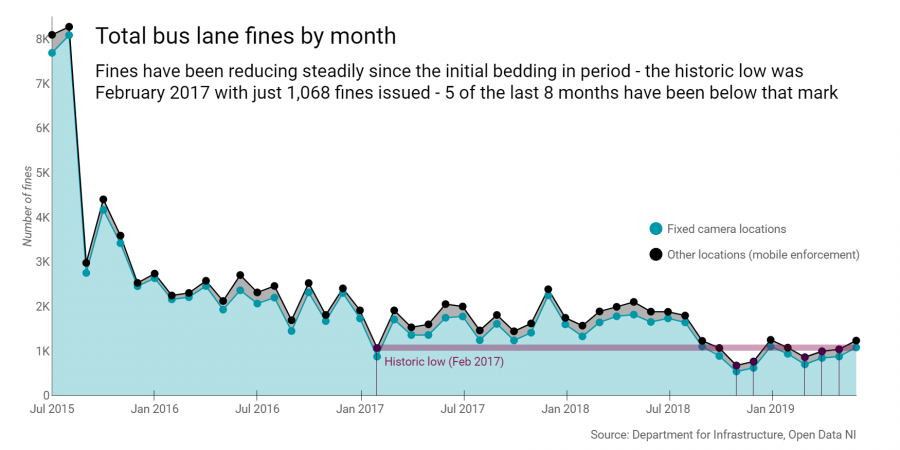
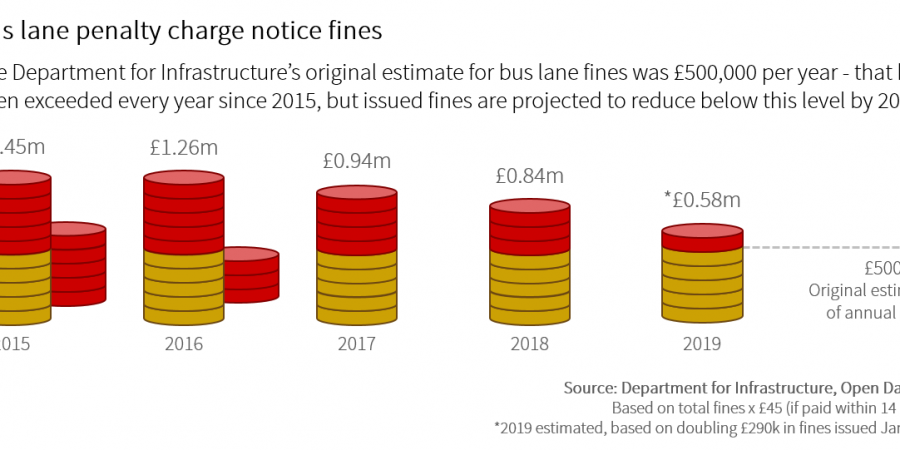
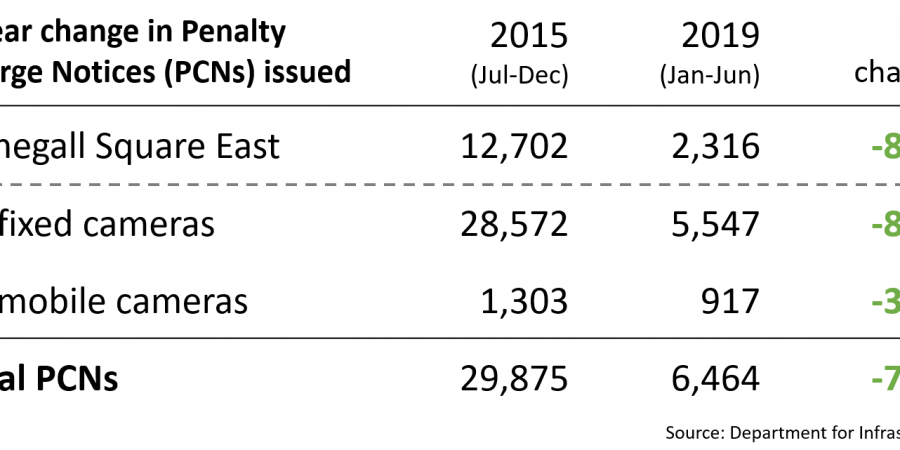
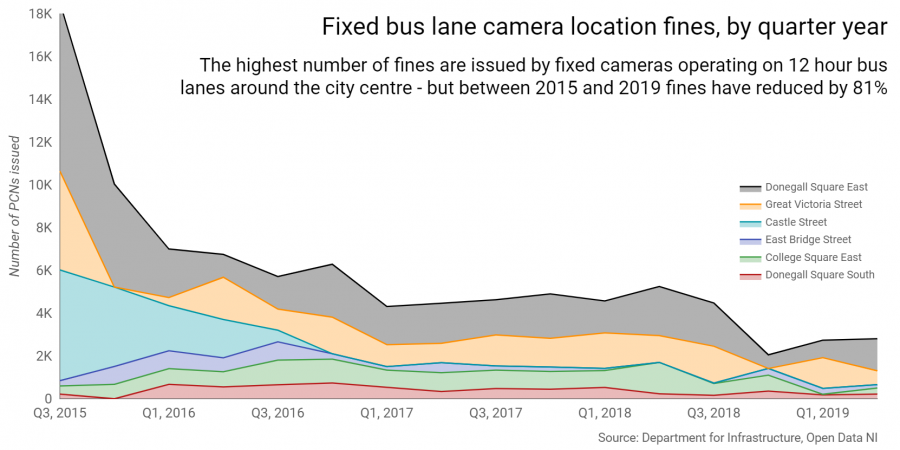
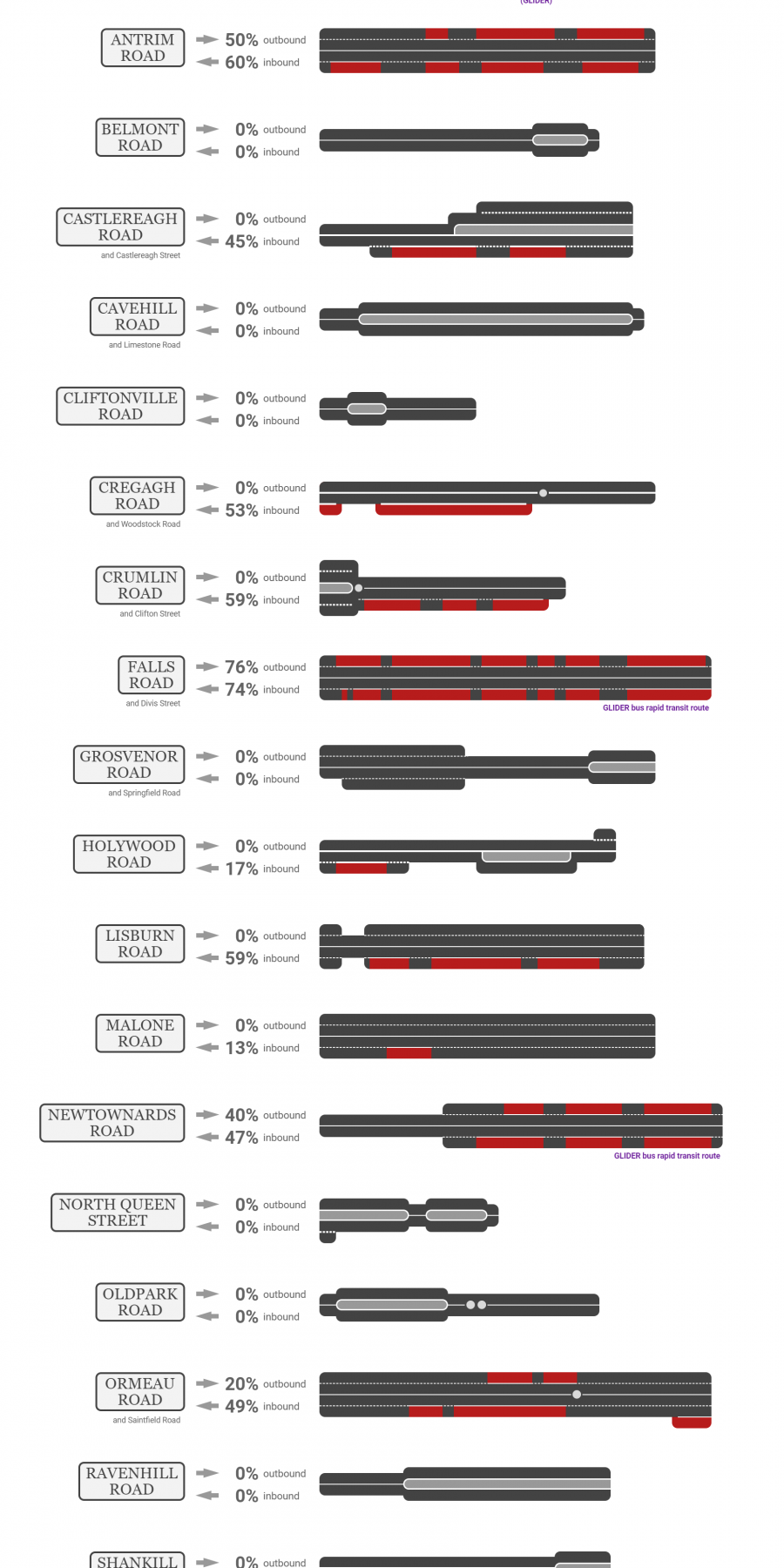


Very well done, this is a fantastic piece of journalism! Thank you.